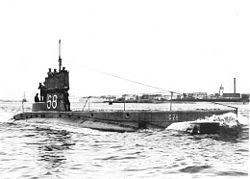Design and description
The C-class boats of the 1907–08 and subsequent Naval Programmes were modified to improve their speed, both above and below the surface. The submarine had a length of 142 feet 3 inches (43.4 m) overall, a beam of 13 feet 7 inches (4.1 m) and a mean draft of 11 feet 6 inches (3.5 m). They displaced 290 long tons (290 t) on the surface and 320 long tons (330 t) submerged. The C-class submarines had a crew of two officers and fourteen ratings. [1]
For surface running, the boats were powered by a single 12-cylinder [2] 600- brake-horsepower (447 kW) Vickers petrol engine that drove one propeller shaft. When submerged the propeller was driven by a 300-horsepower (224 kW) electric motor. [1] They could reach 13 knots (24 km/h; 15 mph) on the surface and 8 knots (15 km/h; 9.2 mph) underwater. On the surface, the C class had a range of 910 nautical miles (1,690 km; 1,050 mi) at 12 knots (22 km/h; 14 mph). [3]
The boats were armed with two 18-inch (45 cm) torpedo tubes in the bow. They could carry a pair of reload torpedoes, but generally did not as they would have to remove an equal weight of fuel in compensation. [4]
Construction and career
HMS C33 was built by HM Dockyard Chatham. She was laid down on 29 March 1909 and was commissioned on 13 August 1910. C33 was involved in the U-boat trap tactic. The tactic was to use a decoy trawler to tow a submarine. When a U-boat was sighted, the tow line and communication line was slipped and the submarine would attack the U-boat. The tactic was partly successful, but it was abandoned after the loss of two C class submarines. In both cases, all the crew were lost.
C33 was one of the two C class submarines lost while employing this tactic. She was mined off Great Yarmouth while operating with the armed trawler Malta on 4 August 1915.
This page is based on this
Wikipedia article Text is available under the
CC BY-SA 4.0 license; additional terms may apply.
Images, videos and audio are available under their respective licenses.
